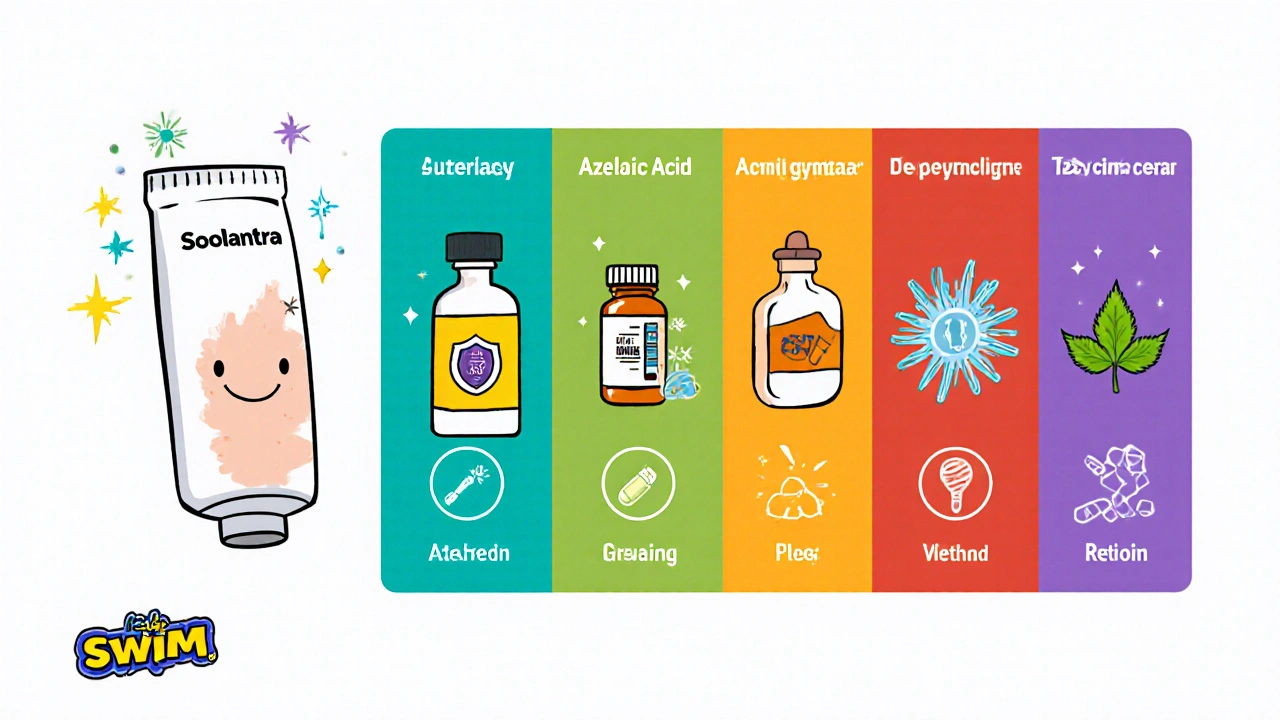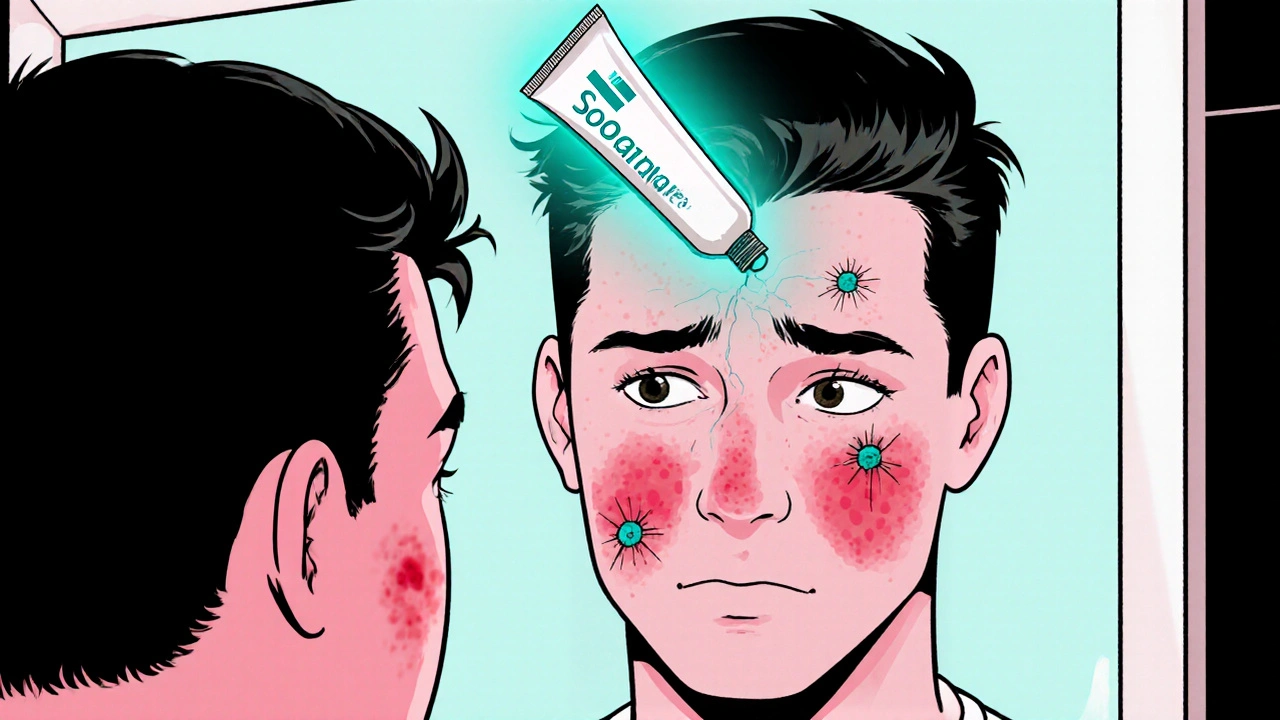Rosacea Treatment Decision Tool
Choose Your Treatment Preferences
Rosacea can feel like a never‑ending battle: persistent redness, bumps, and the occasional flare that makes you want to hide from the world. If you’ve tried a few over‑the‑counter creams with little success, you’ve probably heard about Soolantra, the prescription‑only topical that delivers ivermectin straight to the skin. But is it truly the best option, or do other treatments give you comparable results with fewer drawbacks? This guide pits Soolantra against the most common rosacea therapies, walks through how each works, and helps you pinpoint the right choice for your skin type, severity level, and budget.
What is Soolantra?
Soolantra is a prescription topical cream that contains 0.1% ivermectin, an antiparasitic agent repurposed for dermatology. It was approved by the U.S. FDA in 2014 for the treatment of the inflammatory lesions of rosacea. The formulation is designed for once‑daily application to the affected areas, usually in the morning or evening after cleansing. By targeting the underlying inflammation and the Demodex mites commonly associated with rosacea, Soolantra tackles the condition at its root rather than merely masking symptoms.
How does ivermectin work in the skin?
Ivermectin works through two primary mechanisms. First, it binds to glutamate‑gated chloride channels in the nervous system of Demodex mites, paralyzing and killing them. Second, it modulates the immune response by dampening the production of pro‑inflammatory cytokines such as IL‑1β and TNF‑α. The result is a reduction in both mite density and the inflammatory cascade that fuels redness and papules.
Key benefits and side‑effects of Soolantra
- Rapid symptom relief: Many users notice a visible improvement within 4‑6 weeks.
- Once‑daily regimen simplifies adherence compared with multi‑step topical routines.
- Low risk of skin irritation because the cream base is non‑comedogenic and fragrance‑free.
- Potential side‑effects include mild burning, itching, or dryness at the application site. Rarely, patients develop contact dermatitis.
Topical and oral alternatives worth considering
Before diving into the side‑by‑side matrix, let’s briefly overview the most frequently prescribed rosacea treatments.
- Metronidazole is a topical antibiotic that reduces inflammation and bacterial overgrowth. Concentrations range from 0.75% to 1%.
- Azelaic Acid is a naturally derived dicarboxylic acid that normalizes keratinization and has antimicrobial properties.
- Benzoyl Peroxide is a powerful oxidizing agent that targets acne‑causing bacteria and can help with papulopustular rosacea.
- Doxycycline is an oral tetracycline antibiotic, often prescribed in low, sub‑antimicrobial doses (40 mg) for its anti‑inflammatory effects.
- Tazarotene is a topical retinoid that promotes skin turnover and can reduce persistent erythema.

Comparison table: Soolantra versus common alternatives
| Feature | Soolantra (Ivermectin) | Metronidazole | Azelaic Acid | Benzoyl Peroxide | Doxycycline (oral) | Tazarotene |
|---|---|---|---|---|---|---|
| Mechanism | Anti‑mite + anti‑inflammatory | Anti‑inflammatory antibiotic | Keratolytic + antimicrobial | Oxidative antibacterial | Anti‑inflammatory tetracycline | Retinoid‑mediated skin turnover |
| Typical concentration | 0.1% (cream) | 0.75%‑1% (gel/cream) | 15%‑20% (gel/cream) | 2.5%‑5% (gel) | 40 mg once daily | 0.1% (cream) |
| Onset of improvement | 4‑6 weeks | 6‑8 weeks | 8‑12 weeks | 2‑4 weeks | 4‑6 weeks | 6‑8 weeks |
| Common side‑effects | Mild burning, dryness | Stinging, dryness | Burning, tingling | Dryness, peeling | Photosensitivity, GI upset | Irritation, peeling |
| Prescription needed? | Yes | Yes | Usually Yes | Often Yes | Yes | Yes |
| Cost (US, avg. 30‑day supply) | $150‑$200 | $80‑$120 | $100‑$150 | $70‑$110 | $50‑$90 | $120‑$180 |
Who benefits most from Soolantra?
If you fall into any of the following categories, Soolantra is often the front‑runner:
- Moderate to severe papulopustular rosacea where Demodex mite density is suspected.
- Patients who have tried metronidazole or azelaic acid without satisfactory reduction in lesions.
- Individuals looking for a once‑daily regimen with minimal layering of products.
- Those with a history of antibiotic resistance, since ivermectin is not an antibiotic.
For mild erythema‑predominant rosacea, a gentle cleanser and sunscreen may suffice, reserving Soolantra for flare‑ups or when other agents fail.
Decision factors to weigh when choosing a rosacea therapy
- Severity and subtype: Papulopustular forms respond best to anti‑inflammatory/topical agents; erythema‑dominant cases may benefit from laser or brimonidine.
- Skin sensitivity: If you have a history of irritation, start with lower‑strength azelaic acid or a regimen that alternates days.
- Convenience: Oral doxycycline requires daily pills; topical agents need consistent application, sometimes twice a day.
- Cost & insurance coverage: Soolantra’s price can be offset by pharmacy benefits; many insurers still list metronidazole as a preferred alternative.
- Potential interactions: Retinoids (tazarotene) should not be combined with harsh exfoliants. Antibiotics may interact with blood thinners.
Practical tips for using Soolantra and its alternatives
- Always start with a clean, dry face. Pat gently with a soft towel; avoid rubbing.
- Apply a pea‑sized amount of Soolantra to each affected area. Spread thinly-over‑application doesn’t speed results.
- Wait 5‑10 minutes before applying moisturizers or sunscreens to allow the medication to absorb.
- If you experience a burning sensation, reduce frequency to every other day for one week, then resume daily use.
- For metronidazole or azelaic acid, consider using them at night and a soothing barrier cream (e.g., ceramide‑rich) in the morning.
- Oral doxycycline should be taken with food to lessen stomach upset, and you should avoid excessive sun exposure.
- Maintain a symptom diary: note redness scores, lesion counts, and any side‑effects. This helps your dermatologist fine‑tune the regimen.
When to seek professional guidance
Rosacea can overlap with other dermatologic conditions such as acne vulgaris, seborrheic dermatitis, or lupus rash. If you notice any of the following, book an appointment:
- Rapid spreading of lesions beyond the face.
- Severe swelling, pain, or ocular involvement (eye redness, itching).
- Persistent burning despite stopping the product for a week.
- Desire to combine multiple treatments-only a clinician can ensure safety.
Bottom line: Is Soolantra the right pick for you?
For many people battling stubborn papules and pustules, Soolantra delivers a targeted, once‑daily solution that outperforms older antibiotics in both speed of improvement and tolerance. However, its higher price tag and prescription requirement mean it isn’t the first line for every case. If you have mild redness, a gentle azelaic acid or metronidazole may be enough. For systemic inflammation or when topical agents fail, low‑dose doxycycline remains a solid fallback.
The smartest approach is to assess your rosacea subtype, weigh cost versus convenience, and discuss options with a dermatologist who can tailor the regimen to your skin’s unique needs.
Frequently Asked Questions
How long does it take for Soolantra to show results?
Most patients notice a reduction in redness and lesion count after 4‑6 weeks of consistent once‑daily use. Full clearance can take up to 12 weeks for severe cases.
Can I use Soolantra with other rosacea products?
Yes, but keep the regimen simple. Pair Soolantra with a gentle moisturizer and broad‑spectrum sunscreen. Avoid layering another strong topical (e.g., retinoids) unless your dermatologist advises a staggered schedule.
Is Soolantra safe during pregnancy?
Safety data are limited. The FDA categorizes topical ivermectin as Pregnancy Category C, meaning risk cannot be ruled out. Discuss alternatives with your OB‑GYN or dermatologist.
How does Soolantra compare cost‑wise to metronidazole?
A 30‑day supply of Soolantra typically costs $150‑$200, while metronidazole ranges from $80‑$120. Insurance may cover Soolantra preferentially if other therapies have failed.
What should I do if I experience a burning sensation?
Reduce application to every other day for a week, use a soothing barrier cream, and ensure the skin is completely dry before applying. If irritation persists, contact your dermatologist.


Comments
Zachary Blackwell
October 23, 2025 AT 13:42Yo, anyone else notice how the pharma giants push Soolantra like it’s the holy grail while keeping cheaper alternatives under wraps? They love a good profit churn, especially when they can claim it kills "Demodex mites" – which, by the way, sounds like a spy code word for some secret skin‑control program. I’m not saying it’s a conspiracy, but the way insurance companies suddenly love it after you’ve tried a bunch of generics feels staged. Think about it: they get you hooked on a prescription that costs upwards of $150 a month, then the side‑effects lobby spins the narrative that any mild burn is just "the skin adjusting". If you’re savvy, you’ll ask yourself if the mite hypothesis is really the main driver or just a marketing sleight of hand. The good news? There are legit alternatives that work just fine without the pay‑wall. Stay critical and read between the glossy brochure lines.
prithi mallick
November 2, 2025 AT 21:40i think rosacea is like a metaphor for the inner turmoil we all feel sometimes. when your skin erupts you cant help but reflect on the chaos inside. it's kind of poetic that a tiny mite can cause such a commotion, reminding us of how small thoughts can snowball. maybe you can view each treatment option as a different philosophy: some say accept the redness, others fight it. the key is to be gentle with yourself, even if you misspell a word here and there while writing a diary of your skin journey. remember, progress is not always linear, and a little patience goes a long way. keep noting how each cream feels, and trust that your body will respond in its own time.
Jennell Vandermolen
November 13, 2025 AT 06:39Thanks for the insight! It's helpful to think about the bigger picture behind these treatments. I appreciate the reminder to stay skeptical and do my own research.
Mike Peuerböck
November 23, 2025 AT 15:38Allow me to present a comprehensive perspective on the matter at hand. First and foremost, the pharmacodynamics of ivermectin manifest through dual mechanisms, a fact that warrants meticulous consideration. Second, when juxtaposed with topical antibiotics, one observes a commendable reduction in microbial resistance, thereby preserving future therapeutic avenues. Third, the regimen’s simplicity-once‑daily application-facilitates adherence, a factor often underappreciated in clinical outcomes. Moreover, patients frequently report a diminution in erythema within a matter of weeks, a timeline that eclipses many conventional agents. Fourth, the safety profile remains favorable, with only transient sensations of warmth or dryness reported in a minority of cases. Fifth, the cost, albeit higher than certain generics, may be counterbalanced by insurance formularies, especially when prior treatments have faltered. Sixth, clinicians must remain vigilant regarding potential phototoxicity when integrating concomitant retinoids, a nuance that underscores the importance of individualized care. Seventh, the presence of Demodex mites, while not universally implicated, offers a plausible etiologic target that aligns with contemporary pathophysiological models. Eighth, long‑term studies suggest sustained remission in a substantial cohort, reinforcing the drug’s durability. Ninth, patient education regarding proper application-clean, dry skin, a pea‑sized amount, and a waiting period before moisturizers-optimizes absorption and efficacy. Tenth, a symptom diary can serve as an invaluable tool for both patient and provider, fostering data‑driven adjustments. Eleventh, it remains essential to evaluate comorbidities such as ocular rosacea, which may necessitate adjunctive therapies. Twelfth, the holistic management of rosacea should encompass lifestyle modifications, including trigger avoidance and sun protection. Thirteenth, a multidisciplinary approach, potentially incorporating dermatology, ophthalmology, and nutrition, can yield synergistic benefits. Finally, the decision matrix should be a collaborative dialogue, weighted by severity, patient preference, and economic considerations. In sum, Soolantra stands as a robust option within a nuanced therapeutic landscape, deserving of thoughtful integration into individualized treatment plans.
Simon Waters
December 4, 2025 AT 00:37Soolantra is just another pharma cash‑cow.
Vikas Kumar
December 14, 2025 AT 09:36Look, I’m not here to debate the science; I’m here to tell you that our country’s skin should be treated with pride, not outsourced to foreign labs that don’t understand our climate. The cost of Soolantra is ridiculous, and you can find home‑grown alternatives that respect our heritage. Don’t let an imported cream dictate how you look. Use what’s locally available.